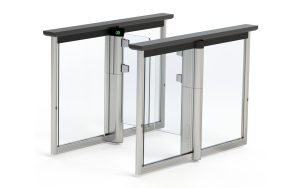Leisure facilities, gyms and fitness centres are designed to be open and accessible to the public, but this openness can make them vulnerable to street crime and other threats if entrances are not properly secured.
The 2025 Health & Fitness Association highlights how gym memberships have reached historic highs, memberships climbed 6% year-over-year, revenue increased an average of 8%, and the number of fitness facilities expanded nearly 4%. These gains confirm what operators and investors have long anticipated: fitness is a core part of today’s connected health, wellness and lifestyle spending.
As the popularity of fitness grows and operational timeframes change to 24/7 to suit the different life patterns of users; leisure centres, gyms and pools face a significant challenge to keep people, staff and visitors safe and secure. In addition, they must also safeguard a lot of young or vulnerable people without compromising openness and accessibility.
To meet these needs, security technology must be carefully integrated. It should operate remotely with real-time monitoring, remain unobtrusive and blend seamlessly into its surroundings. This is particularly important for unmanned facilities and during peak gym hours, from 5am to 9am in the morning and 8pm to 11pm in the evening, when vigilance is all-important due to nighttime conditions where everyone is more vulnerable.
To adapt to the growing demand for leisure facilities and evolving security risks, a proactive approach to security and monitoring is required. So, as leisure facilities face rising demand and evolving security risks, how can they integrate gym security access that maintains a welcoming atmosphere while ensuring strict guest safety standards?
Understanding the risks
It is crucial to understand what aspects might make a leisure centre more appealing to potential offenders. One issue is tailgating, which highlights the importance of fitness centre security gates that restrict access to authorised users, such as paying members and staff. Although tailgating is largely opportunistic, it can lead to significant revenue losses.

Changing rooms and lockers in fitness centres, gyms and leisure centres can be crime hot spots
The potential for high rewards is another consideration, as leisure centres commonly feature changing rooms and lockers, which can present a prime target for criminals. Parents might leave belongings unattended while watching their children, and professionals may store valuable items in lockers before or after work. The total value of items stored in lockers can be substantial and comprise much more than mobiles and keys.
Rather than breaking into a facility, a criminal may enter as a paying visitor and proceed to commit crimes. The risk-to-reward ratio is favourable for offenders: with minimal time and effort to pry open a locker. Any noise generated would likely go unnoticed amidst the general sounds of a pool, gym, or background music.
There is a need for Leisure centres to be focused on proactive security protocols, training, and procedures that must be robust enough to identify and manage incidents in real-time.
Developing the response
Many leisure centres primarily focus on protecting personal items through lockers, conducting DBS checks for lifeguards and other key personnel, and securing potentially hazardous chemicals like chlorine. These measures are not always sufficient for addressing the range of threats present in today’s environment.
Utilising smart fitness surveillance systems and visual verification primarily to record incidents for evidence collection rather than for live monitoring, which limits their ability to provide real-time responses to suspicious activity.
More advanced technologies, such as facial recognition and fingerprint scanning, have previously been considered for monitoring attendance or preventing unauthorised access. Guidance from the Information Commissioner’s Office (ICO) has restricted the use of these tools in response to privacy concerns, curbing the deployment of biometric security.
Facilities must look to alternative methods to strengthen gym security without infringing on privacy rights: implementing targeted training programs, creating greater situational awareness, and developing a more comprehensive security strategy.

Gunnebo Entrance Control SpeedStile FLs gym security access solution
Gym security access systems provide an effective means of managing access. By allowing only one person to pass at a time, they prevent tailgating and ensure every entry is verified, especially supportive for unmanned 24/7 facilities. Well-lit, secure entrances further enhance user confidence, especially during early or late times where light levels are reduced.
Supporting a safe and accessible environment for all
Traditionally, fitness centre security measures have focused on safeguarding rather than crime prevention. There is a growing awareness that proactive measures, such as staff training to recognise suspicious behaviours, can help create a safer environment.
Yet the biggest challenge is balancing this need for gym entrance security with the desire to be inclusive and welcoming. While measures like entry gates, CCTV, and secure lockers can significantly reduce risks, they must be implemented thoughtfully to avoid creating a fortress-like atmosphere.
Strategically designed security gate solutions can blend seamlessly into the facility’s layout, providing unobtrusive protection without detracting from the user experience.

Improving security in leisure, fitness and gyms means integrating gym entrance security
Improving security in leisure centres requires more than just investing in the latest technology; it demands a holistic approach that integrates tailored entrance control measures, community-friendly designs, and a strong security culture.
In doing so, leisure centres can maintain their role as vital community spaces that promote health, connection, and safety for all.
